Matador Network's Blog, page 372
January 2, 2023
This Swiss Hotel Offers Unparalleled Mountain Vistas
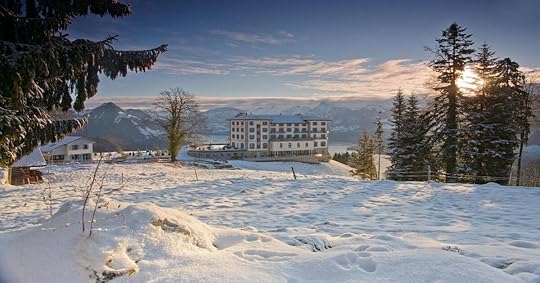
The Hotel Villa Honegg is an iconic 5-star luxury hotel located in the Swiss town of Ennetbürgen, an hour south of Zurich. The property’s unique architectural style, luxurious amenities, and stunning vistas make it one of the most sought-after retreats in all of Switzerland.
Built in 1905 by Hotelier Constantin Honegg and his wife, the property has undergone a number of renovations over the years, but still remains true to its original structure. Guests of the Hotel will find a number of deluxe rooms and suites, each with its own unique style, as well as an award-winning wellness and spa center. The hotel also features an array of world-class dining options to satisfy any palate. From international offerings to the finest local Swiss cuisine, guests are sure to find a new favorite meal each day of their visit.
We hope you love the Swiss accommodations we recommend! Just so you know, Matador may collect a small commission from the links on this page if you decide to book a stay. Listed prices are accurate as of the time of publication.
Situated atop a mountain, the Hotel Villa Honegg offers guests unparalleled access to the area’s breathtaking natural beauty. Whether sipping a glass of wine on the terrace overlooking Lake Lucerne or taking in the mountain views from one of the Hotel’s balconies, guests can enjoy a variety of activities, including skiing, golfing, hiking, and much more. Hotel Villa Honegg also offers an exquisite spa experience with its sauna, pool and massage services.
This luxurious hotel is ideal for romantic getaways or family vacations alike. It boasts 23 individually designed and furnished rooms and suites, each with its own unique character. The property also features a gourmet restaurant with dishes made from the freshest local Swiss ingredients.
The Hotel Villa Honegg provides guests with an unforgettable experience that is sure to be remembered for a lifetime. Whether you’re looking to escape the stresses of everyday life or simply spend time with family and friends, Hotel Villa Honegg is the perfect destination.
With a beautiful location, luxurious amenities, and top-notch service, this is the ideal choice for an unforgettable Swiss vacation. Book your stay now and experience a truly unique and memorable property.
More like thisInsider GuidesThe 7 Most Adorable Villages in SwitzerlandDecember 30, 2022
The 4 Best Women’s Hiking Shorts and Pants Under $50 Right Now

One of the best things about hiking — aside from getting to spend time in nature, seeing some of the most beautiful places on the planet, and the fantastic health benefits — is that you can do it year-round. Though brands tend to introduce their new hiking clothing in spring, in many parts of the country, winter is the best time for hiking. So if you buy hiking shorts before new gear launches, you can often find it on a screaming deal.
But you can’t just buy any pair of women’s hiking shorts off the internet. Wearing the wrong shorts or pants while hiking can lead to everything from sunburn and rubbing to big bites, and sweaty legs, or even a cold evening, if you happen to get soaked while wearing pants that don’t dry very quickly. Just like having the wrong shoes can give you blisters, the wrong shorts can lead to chaffing around the waist or thighs (ouch).

Photo: wavebreakmedia/Shutterstock
Fortunately, I do a ton of hiking, and was able to get my hands on some of the best under-the-radar women’s hiking shorts available on the market. I tested them through a hiking trip to Alaska, on 90-degree hikes around Vancouver, and while hiking in remote parts of British Columbia in late fall. And after testing a handful of pairs, I can confidently say these are the four best women’s hiking shorts and pants for most women looking to hit the trails in the coming months — and they’re all currently under $50.
We hope you love the items we recommend below! Just so you know, Matador may collect a small commission from the links on this page if you decide to make a purchase. Listed prices are accurate as of the time of publication.
The best for comfortThe best for distance hikingThe best quick-drying (and best for curves)The best multi-sport short What to look for in a hiking short Hiking shorts vs. hiking pants The best for maximum comfort: FreeFly Apparel Breeze Short
Photo: FreeFly Apparel
Pros: Incredibly soft, dries quickly, built-in underwear, stretch fabric is flattering on everyoneCons: No side pockets, not very warmMy two cents on sizing: Standard to slightly big — they have a straight, non-fitted cut. But a lot of stretch.My favorite thing about the FreeFly Breeze Shorts is that you can hike in them or lay down for a quick nine hours of sleep and be supremely comfortable either way.
I’ve been a fan of FreeFly for a long time, primarily for their aesthetics (straight lines, solid colors, very classic styles) and the fact that all their clothing (women’s hiking shorts included) have UPF properties to protect your skin. But I recently tried the Breeze Short and they’ve become my go-to pair of shorts not just for outdoor activities, but also for running errands or just hanging out around the house.

The “Pull-On Breeze Short” has two front pockets and a slightly boxier cut. Photo: Suzie Dundas
The brand’s much-touted bamboo fabric is probably the most comfortably fabric I’ve ever worn, but it still has the properties you want in a hiking short: it’s quick drying, breathable, stretchy, and weighs nearly nothing. The trade-off then is that the fabric is pretty thin, so I wouldn’t wear it on hikes where I’m likely to be sitting on rough rocks for extended periods of time. But as a super versatile, throw-on-and-go hiking short, I’ve yet to find better.
There are only two things I would change. I’d like side pockets, but since the Breeze is more of a running short, it’s understandable that it doesn’t have them (however, the Pull-on Breeze Short does). And it may be nice if there was a drawstring around the waist, especially if they start stretching out because you haven’t washed them after a few hikes (or is that just me?)
Current price: Starting at $41.99 at Scheels (Or all colors and sizes available at FreeFlyApparel.com for $68)
Best for rugged or long-distance hikes: Sierra Design Fredonyer Stretch Short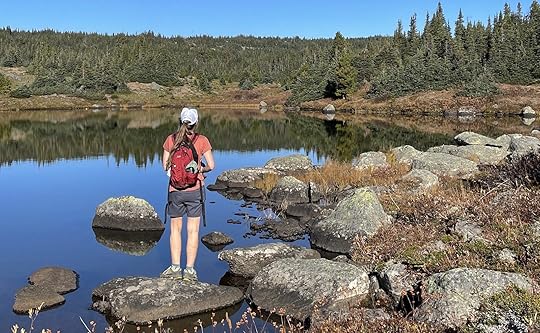
Photo: Suzie Dundas
Pros: Durable, useful pockets, doesn’t show signs of wear, great price, comes in a pantCons: Inseam may be a little long for some buyersMy two cents on sizing: Fredonyer Stretch Short is standard sizing, Fredonyer Pant runs a little slim in the thighs (but stretches)I generally like being light and breezy while hiking and could probably borderline be considered a minimalist hiker — I hiked from the US into Canada in Chacos hiking sandals, after all. But for all-day hikes or more rugged hikes where I know I’ll be going through tight brush, taking breaks on logs, or carrying a more substantial hiking pack with a hip belt, I do prefer a thicker.
Fortunately, the Sierra Designs Fredonyer Short seems to be just that, but it doesn’t have a bulky, boxy look — and it’s very comfortable. Sierra Designs doesn’t make a ton of items — primarily lightweight sleeping bags and backpacking tents, plus a good lightweight rain jacket — but what it does make it makes well, and sells at a decent price, too. So it shouldn’t have surprised me that its hiking gear would be equally useful.
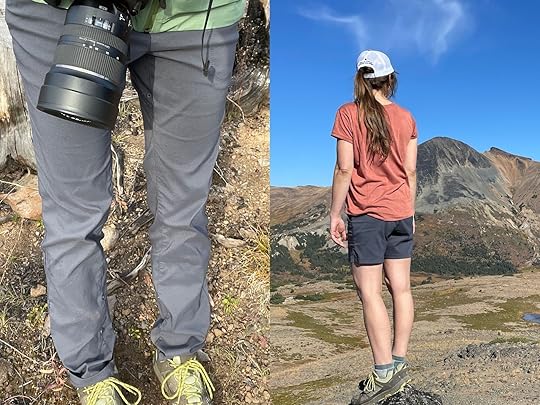
The Fredonyer pants and shorts are very similar, so if you like the materials and features of one, you’ll probably like the other, too. Photo: Suzie Dundas
The Fredonyer Short is loaded with features, including pockets big enough for a cell phone, a built-in adjustable belt, a zippered back pocket, and ventilated fabric inside the legs to reduce sweat. Better still, they also have an SPF 50 rating and seem very durable. I wore them while bushwhacking through a forest fire burn zone in an area full of low brush and broken twigs and sticks and they didn’t snag on anything — nor do they even look like they’ve been worn, really. I tested them on a 12-mile hike and didn’t have any damage to the shorts (or rubbing against my skin) at the end of the day.
These women’s hiking shorts also come in a hiking pant version with similar features (like a ventilated inseam). I found that the pants were a little lower rise than I would normally prefer, but I have rather short legs and a long torso. If your legs are a little shorter and thicker like me, size up so they’re comfortable right out of the box. But they do stretch out after a few hours of wear.
Current price: $49.95 for the shorts (pants are $70)The best quick-drying: Title Nine Switchback Short
Photo: Title Nine
Pros: Big pockets, drawstring waist, curve-friendly, quick dryingCons: Boxy cut, pockets closer to inseam than normalMy two cents on sizing: Seems to be relatively roomy; size down if you like a slimmer cutPretty much every hiking short on the planet is quick-drying, so it’s pretty noteworthy when a pair stands out on top of that. But credit where credit is due to Title Nine’s Women’s Switchback hiking short.
I wore this comfortable, pull-on short while hiking to a waterfall. I didn’t realize you could swim in said falls until I got there, and since I didn’t have a swimsuit, I went in wearing the Switchback shorts. I figured I’d change into a different pair to hike back, but before I could get far enough away from the falls to change in privacy, the Switchback shorts were nearly dry. Considering they were completely submerged, I’d have no hesitations about wearing them on a hike where there was a chance of rain or the potential for a deep stream crossing.
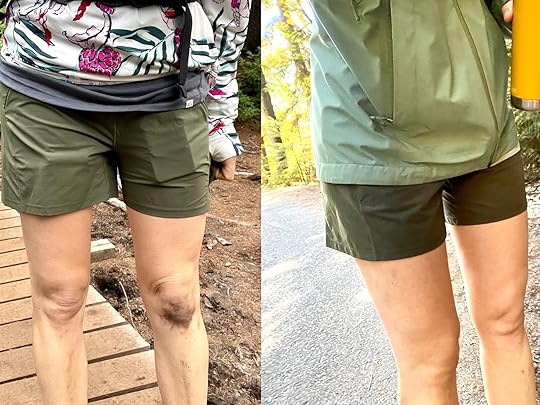
The Switchback’s pockets are very front facing, which means items sit on the front of your thighs — as shown with the Chapstick and phone on the left. But the shorts lie slim against your legs when the pockets are empty (right). Photo: Suzie Dundas
I also really liked that these shorts aren’t over-engineered — a drawstring waist, two front pockets, and a zippered back pocket. So they’ll lend themselves well to just about any active adventure, or just wearing with a white tee and nicer sandals for an al fresco dinner. They’re fairly roomy around the hips and waist in my normal size, so I would size down if I was buying them again. But that means they’d be great for curvier hikers who find other women’s hiking shorts to be a bit too narrow around the butt or thighs.
Also note that the pockets sit directly on the front of your thighs, rather than the sides. It means you’re less likely to drop something when you sit, but it’s different placement from most hiking shorts.
Current price: $29
Buy Now

Photo: Suzie Dundas
Pros: Flattering cut, tons of colors and sizes, anti-wrinkle,Cons: Fabric could be softer, high waist only available with a longer inseamMy two cents on sizing: Exactly as expectedOkay, Patagonia is not exactly an under-the-radar brand. But don’t let that stop you from buying your next pair of women’s hiking shorts from the brand, because it does quite a lot to be sustainable and eco-friendly. That includes offering gear repairs, uses recycled materials, runs a gear buy-back and resale program, and even donates 100 percent of its profits to eco-friendly charities.
I’ve worn several pairs of baggies and prefer the classic style: a higher rise with a five-inch inseam. But they come in a version called “Barely Baggies” with a shorter inseam and lower rise, too. But baggies come in all shapes and sizes, and Matador covered them in-depth earlier this year. Long story short: there’s a reason they’ve been around since the 1980s and are still one of the brand’s most-popular products.
Current price: $21 for the classic baggies in hemp (or $28 for standard; pre-owned starting at $19)Women’s hiking shorts: what to look for
Women’s hiking shorts often have longer inseams than other shorts to protect against chaffing and bunching up. Photo: Izf/Shutterstock
Technically, yes, you can hike in just about any pair of shorts or pants. But for the best hiking experience, you’ll want a pair of women’s hiking shorts designed for wear on the trails. They’re typically made from lightweight, breathable materials such as nylon or polyester, and are designed to be comfortable and functional in a variety of outdoor environments. They’re often a bit longer than non-active shorts to ensure against chaffing or inseam bunching, and may have a variety of features to enhance their performance.
That includes mesh materials or air holes in in high-use area, reinforced stitching or fabrics to protect from abrasion, and larger pockets for safely carrying items like phones or snack bars. They may also be treated with water-resistant or water-repellent coatings to help keep the wearer dry in wet conditions, and could have SPF properties to protect your skin without the need for chemical sunscreen.
Hiking shorts vs. hiking pants
Photo: Mantikorra/Shutterstock
There are a few situations when you might prefer to wear hiking pants instead of shorts, and they’re not all related to temperature.
Rough terrain: If you’ll be hiking on trails that aren’t well-maintained, doing some scrambling, or blazing your own trail, you may want to wear hiking pants to protect your legs from scrapes and cuts. Hiking pants are usually made from durable, abrasion-resistant materials that can withstand rough terrain. They’re also useful in areas with plants that may leave burrs or pointy thorns on your socks. Some pants, including the Fredonyer Stretch Pant listed above, are convertible, allowing you to roll up the hem when you want something closer to shorts.Bugs: If you’ll be hiking in an area with a lot of bugs, opt for a full-length pant. They may be a little warmer, but they’re far more effective than bug spray.Sun protection: If you’ll be hiking in an area with strong sun exposure and minimal shade, you may want to wear hiking pants to protect your legs from the sun’s harmful UV rays. Some hiking pants have built-in UPF (ultraviolet protection factor) ratings to block harmful UV rays. More like thisOutdoorThere Are About 5,000 Women’s Trail Shoes Available. But These Are the Only 6 You Need.
More like thisOutdoorThere Are About 5,000 Women’s Trail Shoes Available. But These Are the Only 6 You Need.
December 28, 2022
This Beach in Bali Is Dream-Like but Also Super Dangerous To Get To
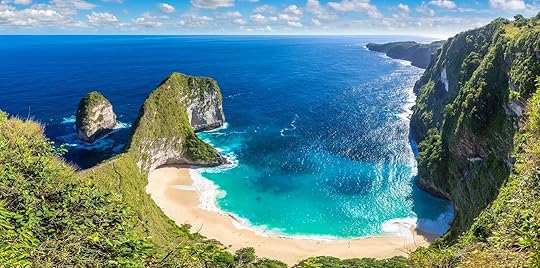
Kelingking Beach, located on Penida Island in the province of Bali in Indonesia, is a postcard-perfect scene. The small bay is sheltered by tall, curved cliffs covered in vegetation; the sand is a soft, yellow color; and the waters are the bright turquoise of your vacation dreams. But you have to earn your spot on this paradisiacal beach — the way there is treacherous to say the least.
@visit Let @laurastravl ♬ original sound – Visit
Before you get to sunbathe and relax to the sound of the crashing waves on Kelingking Beach, you’ll need to tackle the one-hour hike down. While there is a set of stairs that leads down the cliff, only a small portion of it is in good condition — the rest is just an accident waiting to happen.
The start of the stairs (often seen on TikTok or Insta for the view they provide) are made of tall steps framed by makeshift bamboo handrails that are manageable for able-bodies folks, but as you continue to hike down, the stairs become nearly impracticable as the steps are more and more run-down. The steps eventually give way to a rough and rocky vertical path that sometimes has not handrails at all. You’ll be scrambling down and hanging for dear life so don’t get too distracted by the wonderful view.
And while you’ll want to take your time to get down there, hoping not to break an ankle or crack your head in the process, note that there will be a long line of tourists behind you pressuring you to move on. Kelingking Beach is hardly a secret.
Don’t go to Kelingking Beach in your beach outfit, go in your hiking gear. You’ll need solid hiking shoes, sun protection, water, and something more practical than a dress or swimming shorts. Also, Kelingking Beach is not once for insecure swimmers, the waters can be very turbulent. 
Visit Valle Verzasca

Nestled in the majestic mountainous landscape of southern Switzerland’s Ticino region, the Valle Verzasca is one of the most legendary natural swimming pools in the country. Though visitors can dive into almost any area of the Verzasca river, which cuts through the valley, most people head to the rural village of Lavertezzo.
The ice cold waters (even at the height of summer) are deep green in color and pool forms among the rock formations where swimmers can cool off, then climb out and sunbathe after a refreshing dip. The landscape is so idyllic and the water so clear and green that Verzasca is sometimes nicknamed the “Maldives of Switzerland.”
The smooth and sloping rock formations sometimes even form natural rock slides and mini waterfalls. The more daring amongst them enjoy jumping off the stone double arch bridge that spans Lavertezzo, called Ponte dei Salti.

Photo: Florian Muharremi/Shutterstock
According to people who have traveled there before, once you arrive at the river in Lavertezzo, it might look crowded, but people tend to congregate near the bridge. If you prefer a quieter spot, just keep walking along the rock formations until you find a less populated area – there are swimming holes scattered all over the river. Just be sure to avoid the sections of the river with rapids, especially if you’re with children.
Valle Verzasca is a region of stunning mountain vistas that hiking and mountain biking enthusiasts will not want to miss out on. Trails pass through rural towns of Corippo, Lavertezzo and Sonogno, or visit Vogorno and walk across the dam where part of the James Bond movie GoldenEye was filmed. Easy hikes for families include the BoBosco Trail, which features a marble run that kids will love.
How to get to Valle VerzascaLavertezzo in the Valle Verzasca is 30 minutes from the resort town of Locarno, or two and a half hours from Zurich, by car. There are two parking lots in the town of Lavertezzo – one is all day while the other will only
If you aren’t driving, it is possible to take the train from Zurich. The Tenero train takes three hours to reach Locarno, then from Locarno, take the bus until you reach the Lavertezzo, Paese stop, another hour and fifteen minutes. If you’re planning a visit to Valle Verzasca, it’s probably better to say overnight in Locarno, and then plan a day trip from there.
Once you get to Lavertezzo, there’s a dirt path that runs along the side of the river. From the path you should be able to see the Ponte dei Salti. Walk along the path until you get to the bridge, cross it, and then traverse the rock formations (carefully!) until you find an unoccupied spot on the rocks to spread out your blanket and go for a swim. 
Long Ke Wan Is One of the Best Kept Secret Beaches in Hong Kong

If you visit Hong Kong, you’re probably immersed in bustling city lights – traffic, skyscrapers, and street food. A day trip out of the city to relax on one of the most beautiful beaches in the world might be just what you need. Long Ke Wan, part of Sai Kung East Country Park, is close to Hong Kong, easily accessible, and features one of the most beautiful vistas in this region.
Long Ke Wan is a quiet, secluded bay (similar to Thailand’s Maya Bay) surrounded by pine tree forests. It features a crescent shaped white sand beach, and unobstructed views of the South China Sea. Long Ke Wan is less clogged with tourist groups than other beaches in this region, perhaps because it requires more planning to get there. This remote location also offers hiking trails – but be sure to bring your own supplies because there are no restaurants or accommodations here.
How to get to Long Ke WanIn order to get to Long Ke Wan, you need to make your way to Sai Kung, a fishing village on the Sai Kung Peninsula. Sai Kung is a 25 minute car ride, or an hour long bus ride, from Hong Kong. If you’re taking the bus, you will disembark at Diamond Hill station in Sai Kung.
Once you get to Sai Kung, you’ll likely see stands and kiosks on the promenade, selling speed boat tickets that will drop you off directly on the beach at Long Ke Wan. This is probably the easiest, fastest, and most scenic way to get to the beach. Once you get there, you’ll need to buy a speedboat ticket back to Sai Kung from the vendor set up on the beach – who also happens to be one of the few people to sell water and other beverages in the area.
However, if you prefer a long hike, with equally stunning views, you might consider taking a taxi to the High Island Reservoir. From there, it’s a 25-30 minute hike down to the beach.
What to do at Long Ke WanBecause there are no public facilities (except for open air toilets and basic campsites) at Long Ke Wan, this beach is perfect for a day trip, after which you return home to a more populated area with restaurants and hotels. It’s the perfect place to relax, sunbathe, enjoy the scenery, and swim in the calm waters of the bay.
Make sure to pack snacks, water, and towels for your journey. If you’re staying nearby for the weekend, consider exploring the rest of the beaches within Sai Kung East Country Park. Use the Maclehose Trail Section 2 to hike through a string of beaches that includes the more popular (and more crowded) Tung Wun and Tai Wun beaches.
If you are in the mood to explore, be sure to check out the hexagonal rock formations along the coastline, which were formed by ancient volcanic activity. Guided tours are also available of the High Island Reservoir, which is a short hike uphill from Long Ke Wan beach. 
This Adult-Only Resort in Copenhagen Looks Like It’s Actually Set in the Jungle

If you dream of an Indonesian vacation where you would spend your days by the pool in a luxury hotel surrounded by the jungle, know that you don’t have to buy a ticket to Asia to get what you want. Manon Les Suites in Copenhagen has all the components of an extravagant hotel or Airbnb in Bali, but in Denmark’s capital.
@visitSwimming pool dreams in Copenhagen!
This beautiful eco-friendly resort is a little slice of Bali located in the heart of Copenhagen, Denmark.
The best part is the hotel’s location because it’s minutes away from iconic Copenhagen spots such as the Tivoli Gardens and Torvehallernes gourmet-food market.
Would you stay at this hotel?

Manon Les Suites, Denmark
Ig: travelwithadrien
Manon Les Suites in Copenhagen is a five-star, adult-only resort located in the heart of the city, but despite the obvious luxury of the hotel, nothing prepares you for what lies inside.
The most unexpected feature of Manon Les Suites in Copenhagen is its “Junglefish Pool”, which looks like tropical jewelry box. The pool is in the inner courtyard of the square-shaped hotel, tucked in to give the impression of a cocoon far away from the outside world. Hanging plants, flower baskets, and strings of light flow down from the surrounding balconies of the hotel rooms to create the illusion of a lush jungle, a feeling reinforced by the poolside palm trees. The lounge chairs set up in cabanas around the pool allows guests to take in the atmosphere in complete privacy.
The on-site restaurant, Chapung, offers Asian fusion cuisine, and the rooftop lounge is also Bali-inspired, with tiered seating covered in plush mattresses and cushions, as well as large potted plants, reminding guests of terraced rice fields.
The rooms at Manon Les Suites in Copenhagen, however, mix the famous pared down decor and clean lines of Scandinavian design with the rich woods and colorful textiles of Bali — a combination that works extremely well.
If you decide to book a stay at this unique and stunning resort, know that Matador may collect a small commission. 
These Athens Airbnbs Make for a Unique and Cozy Stay in Greece

Athens is one of the oldest cities in the world. Here, you can walk the site where democracy was created in the 6th century BC or see the cave where Socrates drank hemlock in 399 BC. In a span of a day in Athens, you can float in the hot spa waters of Lake Vouliagmeni, have a cocktail at a beach bar, explore an outstanding museum, watch a sunset over the Aegean sea, and dine out in Kerameikos, one of the coolest neighborhoods in the world. These Airbnbs in Athens will allow you to experience the best of the famous Greek hospitality and everything that this city has to offer.
Traveling to Greece? Check out Matador’s accommodation guides to Athens, the islands, and more:9 dreamy Airbnbs in the Greek islandsYou Can Literally Walk Into the Mediterranean Sea From This Airbnb in Greece
We hope you love the Greek villas we recommend! Just so you know, Matador may collect a small commission from the links on this page if you decide to book a stay. Listed prices are accurate as of the time of publication.
Four-bedroom Airbnb in Plaka, Athens
Photo: Airbnb

Photo: Airbnb

Photo: Airbnb

Photo: Airbnb
You can share this spacious villa with up to ten guests. Two full bathrooms, a large kitchen, a spacious living space, and a washing machine will offer all of the comforts you need for a long-term stay. Plaka is a historical neighborhood of Athens around the slopes of the Acropolis. Here, the archeological site of Acropolis and the Acropolis Museum are on your doorstep as well as numerous restaurants, small grocery stores, and gift shops. Most streets are closed to traffic and you will be able to enjoy the picturesque Plaka on foot undisturbed.
Ten guests, four bedrooms
Price: $174 per night

Photo: Airbnb

Photo: Airbnb

Photo: Airbnb

Photo: Airbnb
Wake up to views of the Acropolis without having to get out of your bed. This penthouse loft features glass walls offering a panorama of Athens and a private rooftop deck with a pool. The space is complete with a well-equipped kitchen and a dedicated area for work. From this rental, you will be able to explore most of Athens on foot. Syntagma Square and the retail shops of Ermou Street are three minutes away. You can walk to the Acropolis in 10 minutes.
Two guests, one bedroom
Price: $122 per night

Photo: Airbnb

Photo: Airbnb

Photo: Airbnb

Photo: Airbnb
You will feel like you are on one of the Greek islands in this cozy villa on the slopes of the Acropolis. Anafiotika, where the villa is located, is a tiny hidden neighborhood within Plaka. The island-like feel is not accidental — Anafiotika was commissioned to be built by workers from the island of Anafi in the 1800s. Explore the narrow whitewashed residential lanes of Anafiotika to see the village’s original homes, two Byzantine churches, and the views of the Lycabettus Hill across from the Acropolis. The renovated villa will offer you a modern, fully-equipped stay with multiple outdoor spaces steps away from the shops and restaurants of Plaka and the Acropolis.
Three guests, one bedroom
Price: $128 per night

Photo: Airbnb

Photo: Airbnb

Photo: Airbnb

Photo: Airbnb
This loft truly reflects the eclectic vibes of the surrounding neighborhood. Gazi is one of the most ethnically diverse areas of Athens and is known for its restaurants, bars, and music scene. The old gasworks complex in the neighborhood has been turned into an industrial museum and a cultural venue, Technopolis. The open-concept loft has an industrial aesthetic and is filled with unique hardwood pieces and would make a great home base for a solo traveler or a couple. The loft comes with a fully equipped kitchen, a washer, and a separate desk for work. The loft is located on a quieter residential street, but only five minutes away from a metro station that will take you to central Athens in two stops. The neighborhoods of Thisseio and Monastiraki are a short walk away.
Three guests, one bedroom
Price: $61 per night

Photo: Airbnb

Photo: Airbnb
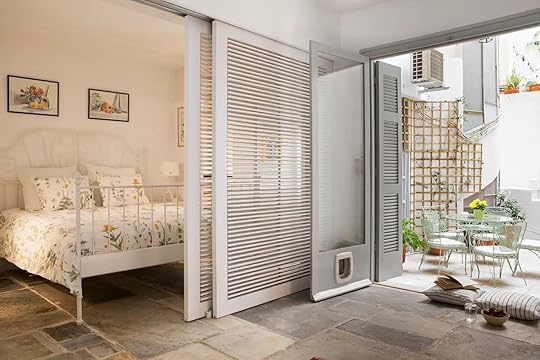
Photo: Airbnb

Photo: Airbnb
Kolonaki is the high-end neighborhood of Athens that’s tucked away from the typical tourist routes, but central enough that you could walk to all of the major attractions. Plaka is a 20-minute walk from Kolonaki; while the National Garden and the Syntagma Square are only 10 minutes away on foot. Kolonaki is filled with fashion boutiques, coffee houses, and upscale restaurants. The apartment is a bright oasis that opens up onto your own private courtyard. This Airbnb is newly renovated, fully equipped, and comes with its own fireplace. If you stay in Kolonaki, make sure to climb the Lycabettus Hill close to sunset for one of the best views of the Acropolis and the Aegean Sea.
Four guests, one bedroom
Price: $73 per night

Photo: Airbnb

Photo: Airbnb

Photo: Airbnb

Photo: Airbnb
If you want to stay off the beaten path in Athens, this bohemian home in Exarchia is the space for you. Up to four people can share this rental with multiple levels and a unique courtyard. The Airbnb is centrally located — you will be able to walk to the National Archaeological Museum of Athens and take a short metro ride to get to Plaka or the Acropolis. Exarchia has great coffee shops and restaurants, but you are not likely to see many tourists in this part of Athens.
Four guests, two bedrooms
Price: $67 per night

Photo: Airbnb

Photo: Airbnb

Photo: Airbnb
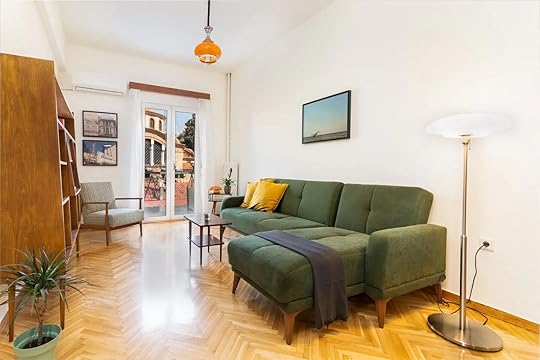
Photo: Airbnb
If you are looking for a stay in Athens on a low budget, check out this apartment with a mid-century modern decor located a short metro ride away from the center of the city. The rental has an outdoor terrace that overlooks a courtyard with a Byzantine Church of Agios Nikolaos. The metro station of Agios Nikolaos is just around the block and is only four stops away from Monastiraki station in the heart of Plaka. The apartment comes with a washing machine and a full kitchen and would make a comfortable long-term lodging.
Three guests, one bedroom
$30 per night

Photo: Airbnb

Photo: Airbnb

Photo: Airbnb

Photo: Airbnb
If you plan to take a ferry to one of the islands or do a yacht charter, this stay in Marina Zeas on the coast of Athens is the way to go. Located on a quiet residential street, the apartment is 10 minutes away on foot from the port of Piraeus. The Airbnb features a fully-equipped kitchen and a large covered patio. An Uber or a taxi ride will take you to central Athens in 15 minutes.
Four people, one bedroom
Price: $76 per night
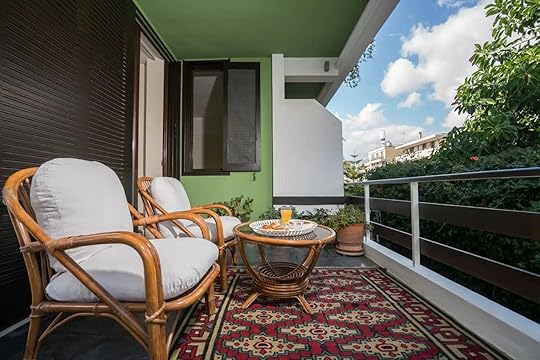
Photo: Airbnb
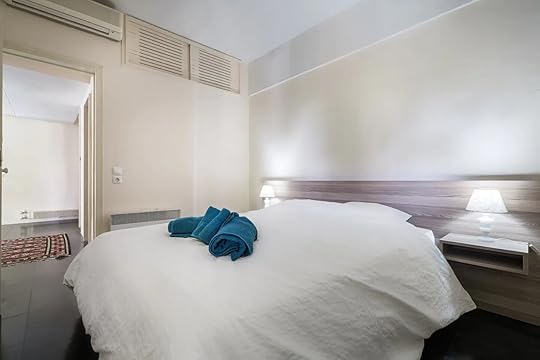
Photo: Airbnb

Photo: Airbnb

Photo: Airbnb
If you don’t have enough vacation time to both visit the city of Athens and travel to the Greek islands on a single trip stay in the Athenian Riviera and have the best of both worlds. Athenian Riviera is the 44-mile coastline that stretches from Piraeus to Sounion. This holiday rental in the Athenian suburb of Voula is a short walk from an organized beach, close to the seaside restaurants and nightlife of Glyfada, and is only a 20-minute drive from central Athens. If you’re feeling adventurous, you can take a 1.5-hour coastal tram ride from Syntagma Square to Voula.
Four people, one bedroom
Price: $79 per night

Photo: Airbnb

Photo: Airbnb

Photo: Airbnb

Photo: Airbnb
Located on the top floor of an elegant building, this Athens Airbnb offers stunning views of the Acropolis and the surrounding cityscape. Guests can enjoy a spacious terrace with outdoor furniture and a fully equipped kitchen.
Twp guests, studio
Price: $90 per night

Photo: Airbnb

Photo: Airbnb

Photo: Airbnb

Photo: Airbnb
This Airbnb is perfect for those looking for a more modern accommodation experience in Athens. It has air conditioning and heating, as well as access to a private balcony with views of the city from its 8th floor location.
Two guests, one bedroom
Price: $33 per night

Photo: Airbnb

Photo: Airbnb

Photo: Airbnb

Photo: Airbnb
You’ll love staying in one of the oldest neighborhoods in Athens, close to the hustle and bustle of the city. Inside, guests will find a fully equipped kitchen with modern appliances and air conditioning.
Six guests, two bedrooms
Price: $58 per night

Photo: Airbnb

Photo: Airbnb

Photo: Airbnb

Photo: Airbnb
This Airbnb is located in the historic neighborhood of Monastiraki, with easy access to some of Athens’ top attractions. The home offers two bedrooms and two bathrooms with air conditioning and modern amenities, as well as a terrace for outdoor relaxation.
Four guests, two bedrooms
Price: $162 per night

Photo: Airbnb

Photo: Airbnb

Photo: Airbnb

Photo: Airbnb
Located in the prestigious Kolonaki neighborhood of Athens, this property is just minutes away from some of the city’s top attractions. Inside, guests will find two bedrooms, air conditioning, and a private garden.
Three guests, one bedroom
Price: $66 per night

Photo: Airbnb

Photo: Airbnb

Photo: Airbnb

Photo: Airbnb
This Airbnb offers luxurious amenities and modern furnishings, as well as breathtaking views of the Acropolis from its rooftop terrace. Guests can enjoy air conditioning, a fully equipped kitchen, and all necessary amenities for a comfortable stay in Athens.
Six guests, two bedrooms
Price: $274 per night

Photo: Airbnb
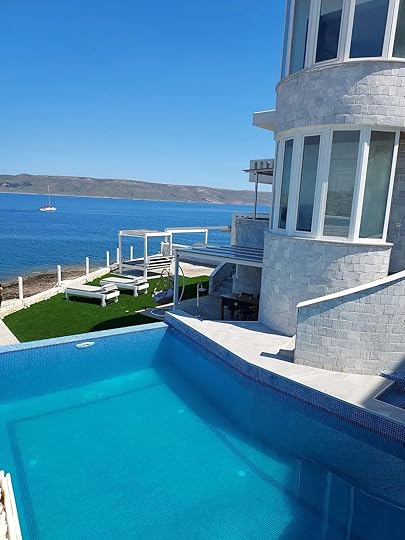
Photo: Airbnb

Photo: Airbnb

Photo: Airbnb
70 km outside of Athens, Cape Sounion is the southernmost tip of the Attic Peninsula and is where the Athenian Riviera ends. Sounion is a popular day excursion from Athens because it houses an ancient archeological site with the eminent temple of Poseidon perched on the cliffs 60 meters above the sea. This spacious villa right on the coast is only 15 minutes away from the temple. Up to ten guests can stay comfortably on three levels of this home with three bedrooms, three bathrooms, additional sleeping spaces in the common areas, and a spacious well-equipped kitchen. The villa comes with a large private garden and multiple outdoor terraces that all overlook the sea. Enjoy your private pool or walk down the cliffs to a beach. You will need a car to drive to Athens in one hour or explore the shops and restaurants of the nearby town of Lavrio (or Laurium). 
Ten guests, three bedrooms
Price: $335 per night
December 27, 2022
This Twice-a-Year Phenomenon Might Be the Best Sunset in California

If you’ve always wanted to see the iconic, once-per-year, framed sunrise at Stonehenge, England, but have never managed to make it across the pond for the summer solstice, know that there may be a similar celestial event closer to home that you could attend: the sunset at La Jolla.
@visitEpic moment in in La Jolla
, a seaside neighborhood within the city of San Diego, California, USA. Twice a year, the sunset aligns perfectly with the Scripps Pier, which tends to fall around early May and early-mid August!
"This sunset alignment that only happens twice a year is a photographer’s dream. Here’s a time lapse view from the best seat in the house. Did you notice the green flashes at the top of the Sun?"
How awesome is this?

La Jolla, San Diego, USA ig: @alexnyeart
M83 – Outro
La Jolla is a seaside neighborhood of San Diego in California where you can catch a beautiful sunset over the ocean daily. But twice a year, once in May and once in August, the sunset is extra spectacular if you know where to go. Below Ellen Browning Scripps Memorial Pier, also know as Scripps Pier, the setting sun is perfectly framed by the pilings of the concrete structure, earning the event the nickname of Scrippshenge. Of course, this unusual sunset is dependent on the weather — cloudy skies, although rare in this part of California, may ruin your view.
Because this special La Jolla sunset is not a secret, arrive early and be ready to be fighting for a spot with many photographers. Everyone wants a shot of this rare event.
Note that Scripps Pier is closed to the public, but walking under it from La Jolla Shores Beach is authorized and encouraged. La Jolla Shores Beach is a very popular spot for swimmers, surfers, and anyone who wants to enjoy the beauty of this mile-long sand beach. 
Guests Can Either Swim or Take a Boat To This Restaurant in the Middle of the Ocean

Located on the pristine south eastern coast of Zanzibar, where the white sand beaches meet the crystal clear ocean waters, this restaurant offers one of the most interesting dining experiences in the world: The Rock restaurant is literally positioned on top of a rock in the middle of the ocean. If you want to scratch the best ocean view in the world from a dinner table off your bucket list, you need to make a reservation here.
@visitLunch break in Zanzibar
Located in the middle of the Indian Ocean off Zanzibar in Tanzania, The Rock Restaurant is a popular floating gourmet restaurant that provides one of the most unique dining experiences. During low tide, guests can walk through shallow waters to get there, but when the tide is high, swimming or riding a canoe is needed to get back and forth between the mainland and the small island-like rock.
Would you love to dine here?

The Rock Restaurant, Tanzania Ig: @joaocajuda
The Rock restaurant had to overcome logistical challenges in order to open – consider how tricky it must be to dispose of waste and keep the lights in the middle of the ocean – but the result is one of the most extreme dining experiences in the world. Here’s what to expect when you get there.
How to get to The Rock restaurantDespite its unusual location, The Rock restaurant is actually easy to get to. Located on Pingwe beach in the small fishing village of Michamvi, the restaurant doesn’t require booking a boat or water taxi to get there.
Though it might look like it’s floating from a distance, the restaurant is actually built on top of a rock, just a few feet from shore. At low tide, diners can easily walk to the restaurant right from the beach.
This is the best time to arrive for your reservation, otherwise you might be stuck wading out to the wooden staircase that leads to the dining room (and sitting in wet clothes for the duration of the meal). In order to avoid any soaking wet customers, the restaurant uses a small canoe to transport groups from the beach to the restaurant steps.
If you want to wade through the warm, turquoise waters of Pingwe beach, plan for your meal to be over at high tide. That way you can forgo the boat altogether and take a refreshing dip in the ocean on your way back to the mainland.
What to eat at The Rock restaurantUnsurprisingly, The Rock restaurant Zanzibar specializes in seafood. When you’re at a restaurant surrounded by plentiful ocean waters, that’s what you’d expect. Dishes include grilled octopus, coconut milk carpaccio (thinly sliced raw fish), grilled lobster, prawns – and of course a fresh catch of the day. The dessert menu focuses on tropical flavors like pineapple, passion fruit, and coconut.
The restaurant can accommodate couples and big groups (this is a great restaurant for a life changing dinner on a big family vacation, or a more intimate evening out). The outdoor terrace is especially romantic in the evenings, when you can gaze up at the unobstructed stars.
The Rock restaurant requires reservations before arriving, so if you’re planning a trip to Zanzibar’s paradise-like coast, make sure it includes dinner here. 
‘
There’s Only One Way To Visit Antelope Canyon. Here’s How To Do It.

Antelope Canyon in Arizona is so much more than an interesting geological formation. The rich, fiery orange of hue and smooth slopes and curves of these rocks draws in eager hikers and photographers into the canyon year after year. In describing this place to other people, visitors use words like “astonishing” and “magical,” and this canyon actually lives up to the hype. But there’s only one way to visit the canyon that respects the landscape and leaves behind little to no footprint.
How to get to Antelope CanyonThe canyon is part of Lake Powell Navajo Tribal Park, and there are two access points: Upper Antelope Canyon and Lower Antelope Canyon. If you’re staying in Phoenix, the drive to the park is around 4 hours. However, Lake Powell Navajo Tribal Park is just 10 minutes from Page, a small town of about 8,000 people – there are hotels and resorts there and in Lake Powell that will put you closer to the canyon.
How take a tour of Antelope Canyon
Photo: username/Shutterstock
Thanks to overcrowding, photo tours in Antelope Canyon were shut down in 2019. However, there are still guided tours into the canyon. Before you head to the park, you’ll need to make a reservation with a guide, through Navajo Nation Parks. You’ll also need a permit to be in the canyon, but most guides include the permit for your group with their fee. 90 minute and hour long tours generally cost anywhere from $40 to $90.
Visitors should be cautioned that the canyon is full of dust, which is kicked up into the air by heavy wind and covers anyone who encounters it. Supportive, close-toed walking shoes are also a requirement.
The best time to visit Antelope CanyonThe best time to visit Antelope Canyon is between March and October, according to VisitArizona. This is the best time of year to view the shafts of light that penetrate the canyon around midday, when the sun is high in the sky, for which the canyon is legendary.
However, VisitArizona also mentions that tours tend to be cheaper in the off season, in November through January. 
Matador Network's Blog
- Matador Network's profile
- 6 followers




